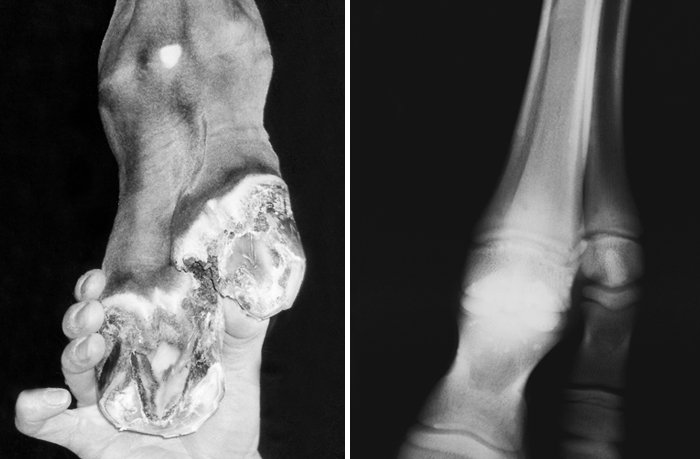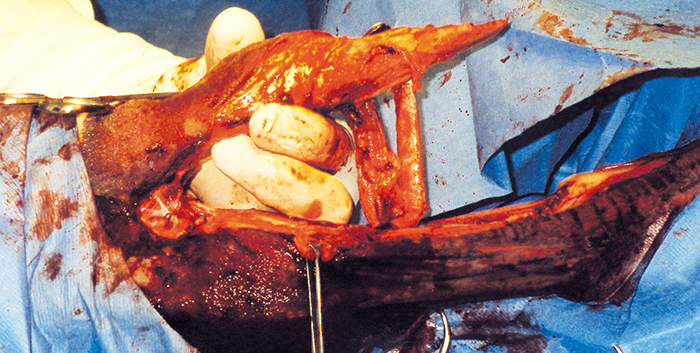When a foal arrives, it’s usually in the middle of the night when owners and trainers are least ready to deal with surprises. This Quarter Horse’s birth gave owners Rick and Joyce Osborne of Cambridge, Minn., a surprise very few people in the world have ever seen.
At 1:30 a.m. on May 28, while they were looking over their new arrival, Joyce blinked and rubbed her sleepy eyes as she looked at their new colt, Spendy. “I wanted to make sure I was seeing straight so early in the morning,” she says. “But I still saw an extra foot on his left foreleg.”
Rare Problem
Except for his extra hoof, Spendy seemed healthy and happy, but the Osbornes had a veterinarian come out that Sunday morning anyway. The vet had heard of a five-footed horse before, but had never seen one. Since the colt was otherwise healthy, the vet suggested they bring him to the Anoka Equine Veterinary Services Clinic in Elk River, Minn., for X-rays and further head-scratching.

Two days later, the X-rays showed two or possibly three extra knee bones and a duplicate cannon bone, fetlock joint, pastern and hoof. Veterinarians Kevin Voller, J.C. Thieke and Kim Voller decided that surgery should be put off for a month. They wanted to see how the slightly knock-kneed colt’s knee would develop, give the colt time to grow stronger to withstand the extensive surgery and give themselves time to research the problem. Surgery was scheduled for June 27.
The Osbornes took Spendy home and handled him normally, turning him out to pasture daily with his mother for exercise and fielding lots of comments about Rick, a part-time farrier, having to shoe five feet. Toward the end of the 1-month wait, the fast-growing colt began hitting himself with the extra hoof. “It wasn’t growing at the same rate as the main hoof,” Joyce recalls. “It was becoming more like a dewclaw on a dog and was getting in his way.”
When Spendy went back to the clinic for more X-rays, the vets decided to remove the extra leg just below the knee and blend the splint bone into the main cannon bone with screws to hold it in place as it calcified. They decided not to interfere with the knee joint as it seemed to be growing normally.
Long Surgery
Beginning with a tourniquet to reduce blood flow to the affected leg, Spendy was on the operating table for nearly 5 hours. There was quite a bit of nerve, tendon and blood vessel work involved, and the vets allowed the Osbornes to watch and photograph the procedure.
After cutting the extra leg free from the connecting tendons and vessels, the splint was screwed to the cannon bone before closing the knee-to-hoof incision around a drainage tube at the cannon bone.

TWO FEET (Left). Spendy’s double foot, trimmed and shaved just before surgery. EXTRA KNEE, CANNON AND FETLOCK BONES (Right). Spendy had a lot more than just an extra hoof.
“Spendy is definitely a fighter!” Joyce laughs. “He wanted to get up sooner than he was able to, so the vet tech and Rick held him up until he got his balance. He was up and nursing on his own before we left that evening!”
The mare and colt spent the next 5 days in the clinic, then went home for 2 weeks of stall rest. Over the next few weeks they were turned out for progressively longer periods while Spendy’s leg was rewrapped every week for 4 weeks.
“He’s doing fantastic!” says Joyce. “We’re weaning him from the bandages slowly. The vets don’t want the leg to swell too much so we’re gradually increasing the time he’s unwrapped when indoors and polo wrapping him when he’s turned out.

REMOVING THE SECOND FOOT. Vets work the second limb free from the tendons and blood vessels of the main foreleg.
“We are expecting a complete recovery and a perfectly sound colt! The vets at Anoka did a phenomenal job,” she continues.
Rick is keeping the foot trimmed as everything heals, and he didn’t even have to worry about shoeing five feet on one horse.







Post a comment
Report Abusive Comment